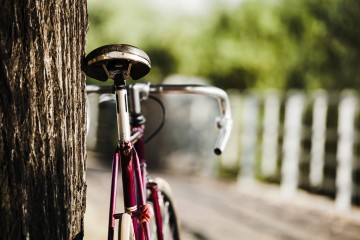On Your Bike: How To Choose The Right Ride
Wednesday, August 27, 2014

Mountain Bikes
You buy a bike, go for a spin, and…promptly experience back, neck, shoulder, hip or genital pain or discomfort. Or maybe you had no discomfort at all but you just didn’t enjoy the quality of your ride. Perhaps the bike felt too slow, heavy, or handled poorly.
What many first-time riders may not know is there are as many different types of bikes as there are types of styles of riding. Choosing the right bike for your goals is an important step in having a comfortable, enjoyable experience that keeps you coming back for more. Even riders with decades of experience may find themselves needing to choose a different type of bike as their bodies change over the years or their riding frequency, duration or intensity does.
This article, the first in a two-part series, aims to help beginners and casual riders select the right type of bike. Though this is not a comprehensive list, inclusive of every type of bike available, it will explore the main categories of bike available to the average urban cyclist.
In part two, we’ll look at how to choose the best bike for your objectives.
What Kind of Bike Do You Need?
Some bicycles are made specifically for a particular kind of riding surface, while others are versatile enough that, with a quick change of tires, they can be ridden both on pavement and on other surfaces, such as gravel or dirt pathways or roads. Here’s a rundown of the basic differences between types of bikes and how they are typically used.
Road Bikes: generally much lighter than a mountain bike and good for riding on pavement. Used for fitness and recreational riding, commuting, long-distance rides, touring and racing, they’re appropriate for riders ranging from beginners to elite athletes. These bikes are sleek, aerodynamic, and extremely efficient.
They are usually equipped with drop bars, aka “curly bars” rather than flat bars. Getting a proper fit for a road bike is critical, as a poor fit can be painful or even harmful to your joints. Because the position of your body on a road bike is more aerodynamic (tilted forward from the hips), back strain may result if your flexibility is sub par.
Touring road bikes can be outfitted with racks, bags, and fenders for commuting or touring, whereas sport and race bikes are designed for minimal add-ons to keep the bike’s weight down and the pedaling efficiency up.
Street Bikes 
Many hybrids come equipped with racks and fenders for commuting purposes. The trade-off for this increased comfort and utility is less pedaling efficiency and a heavier bike. Tires on these bikes tend to be thicker, more flat resistant, and may have a bit of tread on them to provide traction on slightly rougher surfaces such as a groomed dirt or gravel path.
Mountain Bikes: are designed to be ridden on dirt trails or roads over a variety of rough surfaces. The wide, knobby tires of a mountain provide excellent traction in loose dirt or gravel.
Mountain bikes are available with 26-, 27.5- and 29-inch wheels. Generally speaking, the smaller wheeled bikes are less efficient, but more nimble. “29ers” provide decreased rolling resistance and roll easily over obstacles, but are less agile than standard 26-inch bikes. The 27.5-inch wheel size is the latest development in mountain biking and is quickly becoming the new standard, as it combines the improved efficiency of a larger wheel with agile bike handling.
Mountain bikes usually come with disc brakes which provide improved stopping power. There are two basic varieties of mountain bikes:
● Hardtails, which feature a suspension fork and rigid rear triangle. Hardtails are less expensive and lighter than full suspension models, but you will sacrifice handling and comfort on technical singletrack trails.
● Full suspension bikes come equipped with both front and rear suspension shocks, which provide the ultimate in performance and comfort for technical, steep, and downhill backcountry trails. They are designed to be ridden more aggressively, and are able to withstand vertical drops their hardtail counterparts can not safely endure. Full suspension bikes cost much more than hardtails and are usually much heavier, unless you are able to afford a carbon fiber frame.

Wheel size varies but most come with wide tires for a smooth, comfortable ride that diminishes the effects of small rocks and uneven road surfaces. Saddles on these bikes are much wider and more cushioned than any other type of bike, and handle bars are positioned higher, both of which permit a very upright riding position that is easy on the back.
Cyclocross Bikes: Cyclocross is a form of bike racing in which riders do laps on courses designed with a variety of terrain including pavement, dirt trails and grass. Obstacles requiring racers to dismount, shoulder and carry their bikes over them are designed into the course. Cyclocross bikes are most similar in design to road bikes; they feature similar geometry and frame style, are the same wheel size, and are fairly lightweight, yet are tough enough to deal with extreme conditions. Most have semi-knobby tires to provide traction on varied terrain, and many come with disc brakes for improved stopping power in rain and mud.
So which bike is right for you?
Look for part two of this series, which profiles a few sample riders and offers advice for making a good choice. (Hint: It will involve going to a local bike shop and test riding some bikes, so you could get a jump start…right now.)

Related Articles
- Hot for Henna: Five Tips for a Long-Lasting Henna Design
- NW Film Center ’s Top Down Film Series Wraps Up at Hotel deLuxe
- Welcome to GoLocalPDX
- Oregon Ranked 5th in Nation on Breastfeeding Report Card




Follow us on Pinterest Google + Facebook Twitter See It Read It